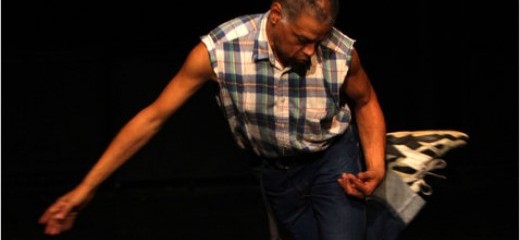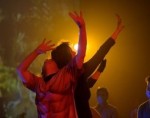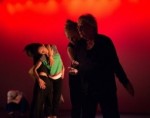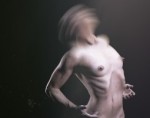
Listening: Improvised Performances at Falls Bridge
by Megan Bridge
Sharon Mansur and Daniel Burkholder start upstage, behind a thin black curtain, turning lanterns with fluorescent bulbs on and off. There are mirrors on the Mascher Space Co-op’s upstage wall, behind the curtain. I happen to know these mirrors were a big debate within the Mascher community, and that their addition to the space makes it more “rentable” to a certain population within Philly’s dance ecology...this thought flickers through my consciousness as Mansur and Burkholder’s silhouettes are duplicated by the wall of mirrors. Other thoughts: They are miners in a cave. They emerge, carrying the lanterns, dressed in white collared shirts. Their movement is purposeful, precise. The image of this pair as workers settles deeper. Their rigorous attention draws me in. I read later in the program notes that Mansur and Burkholder are celebrating 20 years of working together. This fact is apparent in their familiarity with each other’s bodies, weight, physical structures: they have an ease, a command, the freedom to play. One suggests an idea and the other immediately takes it up. There is clear structure here; they shape the space and time of this dance together as they move through it. They are listening: to each other, to the space, to the dance that unfolds beautifully, carefully, exuberantly before us. There is music playing (by Seth Warren-Crow, I find out post-show, curiously uncredited in program notes). I settle into my seat, my pen flies across my page, as Falls Bridge begins on Saturday the 14th of January, 2012. Founded by Curt Haworth and Nicole Bindler in 2010, Falls Bridge is a festival of new movement, improvisation and performance.Caitlin Hellerer presents the second dance; she is joined by Laura Ann Samuelson and Stuart Meyers. They begin in the dark, struggling to insert themselves into/onto a windowsill. They succeed, with some funniness. One wears a long white dress, another a furry hat, the third wears heavy boots. They do things. Things happen. Many different things. Their dance reminds me of one of my favorite assignments from my dance improvisation class in college: Go Do Things. What I loved about this assignment, and love about this dance, is its openness. What I don’t love is that it can easily feel unfocused. A sock comes off. It is smelly (ha ha, we laugh!). A sotto voce argument takes place...the physical exertion, an effort to reach the upstage right corner for a reason we can’t quite hear, one’s head pushing against another’s belly, is convincing. But twice there are distractions...Bindler, our curator, is over at the tech booth...music comes on (uncredited)...was this planned? Part of the improvisation? A whole world of possibilities is open to these performers, but it’s too much. They pass through states without allowing the physicality to develop very far--the movement in this dance seems somewhat unexamined. The performers are excited, which is sometimes exciting. There is a lot of noise, but not so much listening.
Third dance. Enter a large white figure in a dress made of paper...skirt illuminated from the inside with dangling (no, they’re stuffed into her socks, I see later) flashlights. Arms, upper body, and head held as if disconnected...a feeling further emphasized by the fact that the flashlights don’t illuminate the upper half of this lady-creature. She is Baroque. Her gestures are precise, formal...they are telling us something and it is amazing. I want to keep hearing it. I hear the sound of her fingertips crinkling on her paper skirt. She takes off the costume (too soon!), and it’s Zornitsa Stoyanova. She does a silent gesturing, clowning, flirting routine that is familiar to me. I love this dancer, this person, but I want to know more about that unfamiliar creature. The music (pop-ish, and again uncredited) at first closes down potentialities by putting a closed frame around my experience. But Stoyanova can move. She becomes creature again, humanoid this time, with so much depth...articulate and precise in face, hands, and limbs, embodied and expressive. Again, this creature disappears much too soon.
Meg Foley’s dance is next. Her dancing makes me think; her body is always thoughtful. According to program notes, her own dancing makes her notice “...directed versus witnessed decisions. Felt versus visualized trajectories...” I think Foley’s work is quite self-aware, I can see her think through these things, I’m witnessing her as she makes decisions led by her body and her brain. Foley wiggles forward, getting closer to us, lying on her side, head propped on hand. She wiggles backward. There is exertion. She lifts her body in a funny side-bending position, toes pointed towards each other and knees jutting out to the side. “A respite,” she tells us. This brief utterance sends me into a long thought process about the use of text in dance, and prompts me to review its occurrence in the evening’s earlier offerings. I think about language, and its attempt to communicate meaning. When we speak we are immediately rooted in the symbolic. When I watch dance, and when I do it, I struggle to let go of symbolic structures. I want meaning to accumulate, to unfold through images. When movement becomes symbolic, tries to “communicate,” potentialities are closed down. When language comes in, potential often disappears. What is left is Meaning. It’s a one-way street. The audience, when confronted with language, switches over to a different viewing practice. Rather than letting meaning unfold, we try to comprehend (prehend=seize). Language communicates, while movement is more likely to express. Foley speaks only one other time in this dance, to let us know that at this point her movement “is referencing someone. You might know who it is.” This feels like very useful information to communicate, and it simultaneously frames the movement she is doing, which without the comment might feel overtly expressive, somehow out of place.
Ishmael Houston Jones and Yvonne Meier close the evening. In the first section, Jones takes the stage, joined by 4 local dancers seated stage left. They give him single-word directives (“body”--he starts, or stops moving; “eyes”--he opens or shuts them; “mouth”--he begins or stops speaking; and a series of numbers “five,” “three,” “one”--counting down time till the piece ends). OK, so here is something that turns my Foley-centric musings on their head...here is a use of language that is not communicative, or at least not only communicative. Jones begins to speak just as he begins to move...as if opening a floodgate to welcome a torrent. His physicality is confident, expressive, explosive. He repeatedly drops, or throws himself to the floor. I feel bad for his knees. When Greg Holt says “mouth,” Jones begins to speak-- the content is always interesting, but never important to the “meaning” of the piece. Because we know he could get cut off at any time, we don’t get attached to the narrative that begins to unfold. The section ends with Jones speaking: “I’m rubbing my nipple in public. Wei...”
We applaud, Jones stays onstage, and he is joined by Yvonne Meier, who stands at a microphone, paying out continuous commands to Jones. She speaks Swiss-German, which gives most of us, whose understanding of the language is probably piecemeal at best, the chance to again experience language as expressive rather than communicative. Jones responds physically to her sets of commands, always re-setting to the upstage right corner, and traveling downstage towards Meier, and us, on the diagonal. He understands sometimes. “Schnell...” he speeds up, “zurück...” he moves back...”am boden...” he doesn’t go to the floor, to Meier’s mounting frustration. To her louder commands he grows more agitated, responding with wilder physical moves...shouting, barking, falling to the floor but quickly getting up again. I am delighted...I can’t take my eyes off them. Until the two “long songs” that Meier warns us will soon take the piece over. He thinks they are funny, she thinks they are silly. The music is again pop. Again that tightening frame. And, yet again, uncredited...I wonder about this...is there something about the format of an improvisational dance concert that makes the approach to using sound less formal? Or is there a general trend towards music as common property in the minds of choreographers? Or maybe since this is improvisational the artists really didn’t know what their music would be until minutes before they went onstage? This time I am even more distracted by the lyrics...I think Meier and Jones might be, too...their attention seems to shift to commenting on the words; indeed Meier prompts us to listen to the lyrics. Using pop music here is fun but facile. We all have a great laugh, but it’s too easy for them to entertain us. The depth of their dancing, which is compelling, is flattened by the shiny gloss of this intrusion by the culture industry.
The conclusion to Jones and Meier’s dance is met by the evening’s most hearty applause, which could, on second thought, also be a response to the collected weight and impact of the whole evening’s powerful roster of improvisations. These generous movers and commanding performers have given me so much to think about. And I like thinking dance.
By Megan Bridge
January 18, 2012










